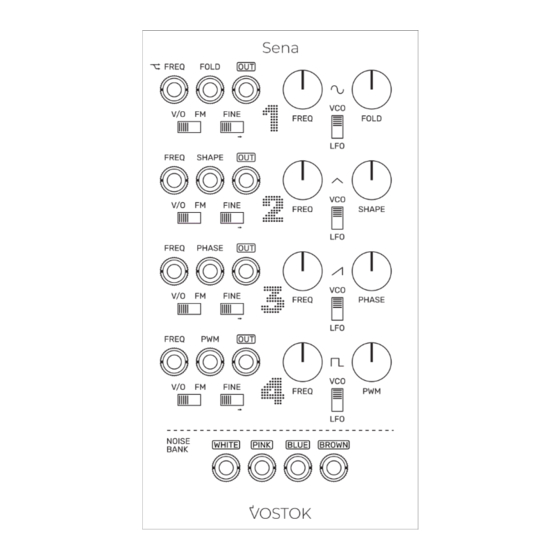Table of Contents
Advertisement
Quick Links
Advertisement
Table of Contents

Summary of Contents for Vostok SENA
- Page 1 SENA MULTI CHANNEL SOUND SOURCE User Manual...
-
Page 2: Limited Warranty
INSTALLATION Sena needs a power supply capable of providing 130mA on each of the +12V and -12V rails, and 14HP of free space in your case. We strongly recommend you to check the current consumption of your system on the ModularGrid website and your power supply capabilities before plugging in the module. -
Page 3: Technical Specifications
On Sena, we decided to reorganize those principles. We have the basic waveforms as on any VCO, but each has an independent core and frequency control. In addition, the tuning inputs of each channel are daisy-chained, allowing to create easy transpositions or detuning between them. - Page 4 OVERVIEW 1. FREQ Input: CV control over the oscillator frequency. It can work as regular V/Oct or as Linear FM Input. The incoming signal is daisy-chained to the next channel. Range: 10Vp-p. 2. Modifier CV Input: CV control over each channel modifier. Range: 10Vp-p.
-
Page 5: Getting Started
GETTING STARTED Sena is laid out in five channels of sound generation. The first four are composed of a VCO and a dedicated waveform modifier, and the fifth is a compendium of four noise generators. Channels 1-4 are identical in functionality, with symmetrical features between them, but entirely different in terms of sound. -
Page 6: Fine Mode
AC Coupled when the FM mode is selected. Daisy-Chain Operation By default, Sena sends the signal present at each FREQ Input to the next one. Each end of the chain has a buffer circuit to keep the voltage accurate. To break the chain, patch a cable on the desired input. - Page 7 VCOs: TIMBRAL ANALYSIS One of the best features of Sena is the timbral diversity of its channels. Sena allows one to control the frequency of each waveform independently and to manipulate its harmonic content, expanding the sonic possibilities of the module massively.
- Page 8 As modulation sources, they are fantastic on FM-style patches thanks to their linearity. Sena’s second channel includes a CV controlled wave-shaper (SHAPE) that morphs our triangle wave into a trapezoid wave and vice versa. The circuit applies a symmetrical clipping stage to the triangle, flattening the...
- Page 9 On Sena, our saw wave generator reached a new dimension with the addition of a dedicated Phase Shifting circuit (PHASE). Based on the “Sawtooth-Driven Multi-Phase Waveform Animator” published by Bernie Hutchins in Electronotes issue 87, the circuit uses a comparator with differential...
- Page 10 (Pulse-Width). The percentage of time that the signal is high is known as a duty cycle. Sena’s Pulse Width Modulation circuit covers a range from a 50% duty cycle (Square wave) to around 96% duty cycle. It...
-
Page 11: Pink Noise
Sena includes a bank with four popular noise generators: White, Pink, Brown, and Blue. The names of the different types of noise came from an analogy to visible light.



Need help?
Do you have a question about the SENA and is the answer not in the manual?
Questions and answers